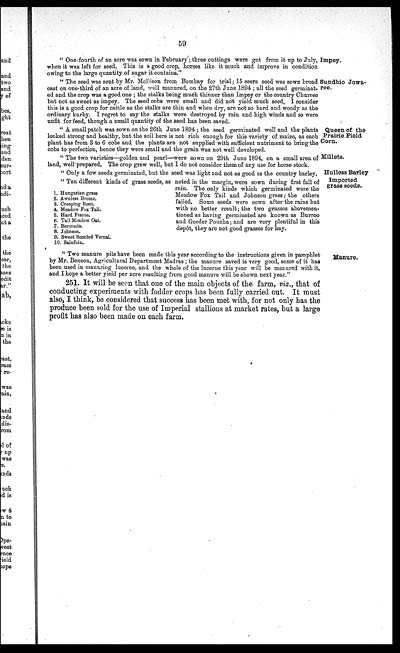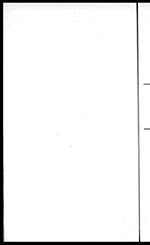Medicine - Veterinary > Civil Veterinary Departments > Annual administration report of the Civil Veterinary Department of India > 1894-1895 > Part I - Imperial report
(75) Page 59
Download files
Individual page:
Thumbnail gallery: Grid view | List view

59
Impey.
" One-fourth of an acre was sown in February ; three cuttings were got from it up to July
when it was left for seed. This is a good crop, horses like it much and improve in condition
owing to the large quantity of sugar it contains."
Sundhio Jowa-
ree.
" The seed was sent by Mr. Mollison from Bombay for trial; 15 seers seed was sown broad
cast on one-third of an acre of land, well manured, on the 27th June 1894 ; all the seed germinat-
ed and the crop was a good one ; the stalks being much thinner than Impey or the country Churree
but not as sweet as impey. The seed cobs were small and did not yield much seed, I consider
this is a good crop for cattle as the stalks are thin and when dry, are not so hard and woody as the
ordinary kurby. I regret to say the stalks were destroyed by rain and high winds and so were
unfit for feed, though a small quantity of the seed has been saved.
Queen of the
Prairie Field
Corn.
" A small patch was sown on the 26th June 1894 ; the seed germinated well and the plants
looked strong and healthy, but the soil here is not rich enough for this variety of maize, as each
plant has from 3 to 6 cobs and the plants are not supplied with sufficient nutriment to bring the
cobs to perfection, hence they were small and the grain was not well developed.
Millets.
" The two varieties—golden and pearl—were sown on 29th June 1894, on a small area of
land, well prepared, The crop grew well, but I do not consider them of any use for horse stock.
Hulless Barley
" Only a few seeds germinated, but the seed was light and not as good as the country barley.
Imported
grass seeds.
" Ten different kinds of grass seeds, as noted in the margin, were sown during first fall of
rain. The only kinds which germinated were the
Meadow Fox Tail and Johnson grass; the others
failed. Some seeds were sown after the rains but
with no better result; the two grasses abovemen-
tioned as having germinated are known as Burroo
and Geeder Poncha; and are very plentiful in this
depôt, they are not good grasses for hay.
|
1. |
Hungarian grass |
|
2. |
Awnless Brome. |
|
3. |
Creeping Bent. |
|
4. |
Meadow Fox Tail- |
|
5. |
Hard Fescue. |
|
6. |
Tall Meadow Oat. |
|
7. |
Bermuda. |
|
8. |
Johnson. |
|
9. |
Sweet Scented Vernal. |
|
10. |
Sainfoin. |
Manure.
" Two manure pits have been made this year according to the instructions given in pamphlet
by Mr. Benson, Agricultural Department Madras; the manure saved is very good, some of it has
been used in manuring lucerne, and the whole of the lucerne this year will be manured with it,
and I hope a better yield per acre resulting from good manure will be shown next year."
251. It will be seen that one of the main objects of the farm, viz., that of
conducting experiments with fodder crops has been fully carried out. It must
also, I think, be considered that success has been met with, for not only has the
produce been sold for the use of Imperial stallions at market rates, but a large
profit has also been made on each farm.
Set display mode to: Large image | Zoom image | Transcription
Images and transcriptions on this page, including medium image downloads, may be used under the Creative Commons Attribution 4.0 International Licence unless otherwise stated. ![]()
| India Papers > Medicine - Veterinary > Civil Veterinary Departments > Annual administration report of the Civil Veterinary Department of India > 1894-1895 > Imperial report > (75) Page 59 |
|---|
| Permanent URL | https://digital.nls.uk/75501298 |
|---|




